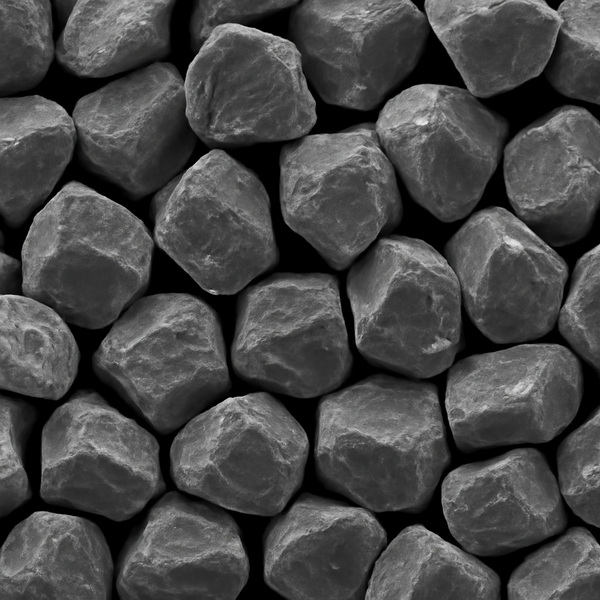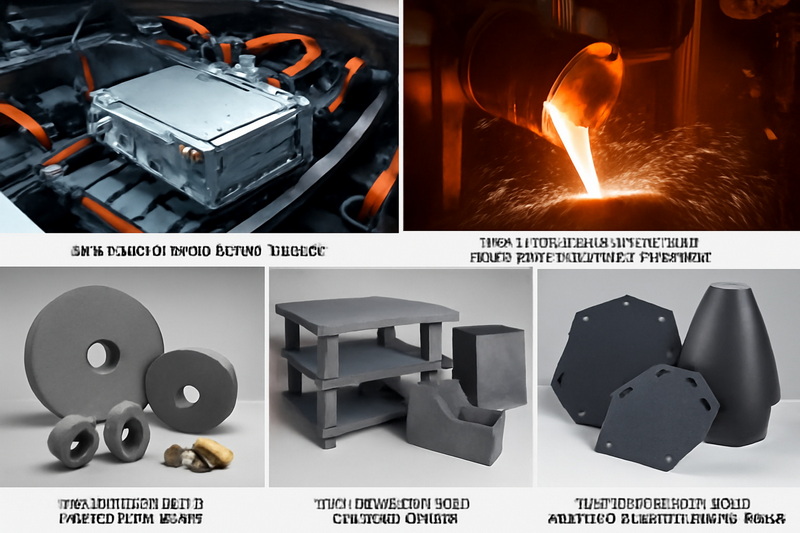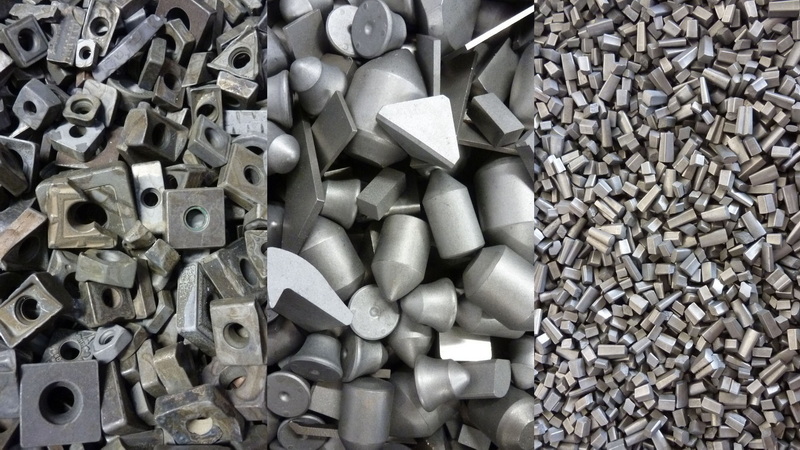Content Menu
● Introduction to Low Temperature Silicon Carbide
● Production Methods of Low Temperature Silicon Carbide
>> 1. Carbothermal Reduction Using Alternative Precursors
>> 2. Magnesiothermic Reduction
>> 3. Microwave-Assisted Synthesis
>> 4. Solid-State Metathesis and Direct Bonding
>> 5. Low-Temperature Sintering with Additives
● Key Properties and Advantages
● Industrial Applications
>> Metallurgy and Smelting
>> Abrasives and Polishing
>> Electronics and Semiconductors
>> Energy and Environmental Applications
>>> 1. Wave-Absorbing Materials
>>> 2. Water Treatment and Filtration
>>> 3. Catalysis and Gas Sensing
>> Advanced Ceramics and Composites
>> Military and Defense Applications
>> Construction and Building Materials
● Case Studies and Emerging Trends
>> Sustainable SiC from Agricultural Waste
>> Rapid Microwave Synthesis for Aerospace Materials
>> Nanostructured SiC for Catalysis and Sensing
>> Integration into Renewable Energy Systems
>> Smart Manufacturing and 3D Printing
● Challenges and Future Prospects
● Conclusion
● FAQ
>> 1. What are the main advantages of low temperature silicon carbide production?
>> 2. How does low temperature silicon carbide benefit the electronics industry?
>> 3. What types of raw materials can be used for low temperature silicon carbide synthesis?
>> 4. What are the key industrial sectors utilizing low temperature silicon carbide?
>> 5. Can low temperature silicon carbide be used for environmental applications?
Silicon carbide (SiC) is a highly valued industrial material, recognized for its exceptional hardness, thermal stability, and resistance to chemical attack. Traditionally, the production of silicon carbide required extremely high temperatures—often above 2000°C. However, recent advances in materials science and engineering have enabled the synthesis and processing of silicon carbide at much lower temperatures. This breakthrough has not only reduced energy consumption and production costs but also expanded the range of possible applications. In this article, we explore the industrial uses of low temperature silicon carbide, examine its production methods, discuss its unique properties, and highlight its transformative effects on sectors such as metallurgy, electronics, energy, environmental protection, and advanced manufacturing.

Introduction to Low Temperature Silicon Carbide
Silicon carbide is a compound formed from silicon and carbon, possessing a crystalline structure that imparts unique mechanical, thermal, and electrical characteristics. The classic Acheson process for silicon carbide production requires temperatures around 2500°C, making it energy-intensive and costly. However, modern low temperature synthesis methods can produce SiC at temperatures as low as 600–1600°C, depending on the process and the desired product form. This shift to lower temperatures not only reduces energy consumption but also enables the fabrication of new SiC morphologies—such as nanowires, hollow spheres, and porous ceramics—that are difficult or impossible to achieve with conventional methods.
Production Methods of Low Temperature Silicon Carbide
1. Carbothermal Reduction Using Alternative Precursors
By utilizing natural minerals like shungite or agricultural waste (rich in silica and carbon), silicon carbide can be synthesized at 1500–1600°C, much lower than the Acheson process. The resulting powders are suitable for abrasives, polishing, and metallurgical applications.
2. Magnesiothermic Reduction
This method involves reacting silica with magnesium in the presence of carbon at temperatures as low as 650°C. The process yields mesoporous silicon carbide hollow spheres, which are ideal for catalysis and environmental remediation due to their high surface area.
3. Microwave-Assisted Synthesis
Microwave sintering dramatically reduces the processing temperature and time required to produce SiC fibers and composites. This energy-efficient technique is viable for rapid production of high-performance materials, especially in aerospace and automotive industries.
4. Solid-State Metathesis and Direct Bonding
Solid-state reactions and advanced surface activation techniques enable the formation of crystalline SiC nanomaterials and wafer-level direct bonding at temperatures as low as 400–600°C. This supports the fabrication of sensitive electronic devices and MEMS components.
5. Low-Temperature Sintering with Additives
The addition of sintering aids such as alumina and boron oxide enables the densification of silicon carbide ceramics at 1100–1400°C. This results in porous ceramics with high strength and tailored porosity, suitable for filtration and catalyst support.
Key Properties and Advantages
- Energy Efficiency: Lower synthesis temperatures directly translate to reduced energy consumption and lower production costs.
- Environmental Sustainability: The use of agricultural waste and natural minerals as raw materials supports circular economy principles and reduces environmental impact.
- Enhanced Material Control: Low temperature processes allow for the creation of nanostructured, porous, or hollow SiC products with customizable properties.
- Compatibility with Sensitive Devices: Low temperature methods are compatible with the fabrication of advanced electronics and MEMS devices, where thermal budgets are limited.
- Improved Mechanical and Thermal Properties: SiC produced at low temperatures can exhibit enhanced toughness, controlled porosity, and improved thermal conductivity, making it suitable for specialized industrial roles.
Industrial Applications
Metallurgy and Smelting
Low temperature silicon carbide is widely used as a deoxidizer and alloying agent in ferrous and non-ferrous metal smelting. Its high thermal conductivity and chemical stability improve the efficiency of furnaces and reduce impurities in metal products. The ability to synthesize SiC at lower temperatures from inexpensive precursors makes it particularly attractive for large-scale metallurgical operations.
SiC also serves as a refractory material in furnaces and kilns, where its resistance to thermal shock and chemical corrosion ensures long service life and minimal maintenance. The use of low temperature SiC refractories can further reduce the overall energy footprint of metallurgical processes.
Abrasives and Polishing
Silicon carbide's exceptional hardness makes it a preferred abrasive for grinding, lapping, and polishing hard materials such as glass, ceramics, and semiconductors. Low temperature production methods yield fine SiC powders and microgrits with controlled particle size distributions, ideal for precision abrasive applications.
The uniformity and purity of low temperature SiC abrasives result in superior surface finishes and reduced tool wear, making them indispensable in the manufacture of optical components, electronic wafers, and precision instruments.
Electronics and Semiconductors
Low temperature silicon carbide is a game-changer in the electronics industry. Its ability to withstand high voltages and temperatures makes it ideal for power electronics, sensors, and high-frequency devices. Low temperature wafer bonding and deposition techniques enable the integration of SiC into advanced devices without damaging sensitive layers, supporting the next generation of ultrahigh-voltage and high-efficiency electronics.
SiC's wide bandgap, high electron mobility, and superior breakdown strength have led to its adoption in electric vehicles, renewable energy systems, and 5G telecommunications infrastructure. Low temperature processes also facilitate the production of SiC-on-silicon heterostructures, enabling cost-effective manufacturing of high-performance devices.
Energy and Environmental Applications
1. Wave-Absorbing Materials
Porous SiC produced at low temperatures exhibits strong electromagnetic wave absorption, making it valuable for stealth technology, EMI shielding, and radar-absorbing coatings. Its lightweight and tunable structure allow for the design of materials that can absorb specific frequencies, protecting sensitive equipment from interference.
2. Water Treatment and Filtration
Mesoporous and hollow SiC structures serve as highly efficient adsorbents and filtration media for removing organic contaminants and heavy metals from water. Their chemical inertness and high surface area ensure long-term performance and reusability.
3. Catalysis and Gas Sensing
Nanostructured SiC produced at low temperatures serves as a robust support for catalysts in chemical processing and air purification. Its resistance to poisoning and thermal degradation extends catalyst lifetimes and improves process efficiency. Additionally, SiC's electrical properties make it ideal for gas sensors operating in harsh environments.
Advanced Ceramics and Composites
Low temperature sintering enables the fabrication of porous SiC ceramics and fiber-reinforced composites with high strength, low density, and excellent thermal shock resistance. These materials are essential in aerospace, automotive, and energy sectors for components exposed to extreme environments, such as turbine blades, heat exchangers, and brake discs.
Low temperature SiC composites are also used in ballistic armor, lightweight structural panels, and advanced sporting goods, where their combination of toughness and low weight is highly valued.
Military and Defense Applications
Silicon carbide's unique properties make it a critical material in military and defense applications. Low temperature SiC is used in the manufacture of lightweight armor for vehicles and personnel, offering superior protection against ballistic threats while minimizing weight. Its high thermal conductivity and resistance to thermal shock also make it suitable for use in missile nose cones, radomes, and infrared windows.
SiC-based ceramics and composites are increasingly employed in advanced weapon systems, radar components, and stealth technology, where their durability and electromagnetic properties provide a strategic advantage.
Construction and Building Materials
Low temperature silicon carbide is finding new applications in the construction industry. Its durability, abrasion resistance, and thermal stability make it an ideal additive for high-performance concrete, flooring, and coatings. SiC-enhanced building materials exhibit improved wear resistance, longer service life, and better performance in extreme environments.
In addition, porous SiC ceramics are used as insulation and fireproofing materials in buildings, providing enhanced safety and energy efficiency.

Case Studies and Emerging Trends
Sustainable SiC from Agricultural Waste
A novel process uses rice husks and straw as raw materials to produce silicon carbide at 500–800°C. The resulting porous SiC is cost-effective and environmentally friendly, with applications in metal smelting, water treatment, and electromagnetic shielding.
Rapid Microwave Synthesis for Aerospace Materials
NASA's development of microwave-assisted SiC fiber production reduces processing temperatures by up to 1000°C, enabling the repair and recycling of high-value aerospace components and expanding the use of SiC composites in extreme environments.
Nanostructured SiC for Catalysis and Sensing
Low temperature methods yield SiC nanowires, nanotubes, and hollow spheres with large surface areas, ideal for catalyst supports, gas sensors, and advanced battery electrodes.
Integration into Renewable Energy Systems
Silicon carbide's superior electrical and thermal properties are driving its adoption in solar inverters, wind turbine electronics, and battery management systems. Low temperature production methods enable the cost-effective manufacture of SiC components for renewable energy infrastructure, supporting the global transition to sustainable power.
Smart Manufacturing and 3D Printing
Emerging additive manufacturing techniques, such as 3D printing of SiC ceramics, benefit from low temperature sintering processes. This allows for the rapid prototyping and production of complex, high-performance components for industrial, medical, and research applications.
Challenges and Future Prospects
Despite its many advantages, the widespread adoption of low temperature silicon carbide production faces several challenges:
- Scale-Up and Process Control: Achieving consistent quality and properties at industrial scale requires precise control over reaction conditions and raw material purity.
- Cost of Additives and Precursors: While agricultural waste and alternative minerals can reduce costs, the need for specialized sintering aids or high-purity precursors may offset some savings.
- Integration with Existing Manufacturing Lines: Retrofitting traditional production facilities to accommodate low temperature processes can require significant investment and technical expertise.
- Material Performance Optimization: Ongoing research is needed to fully understand the relationships between processing parameters, microstructure, and final properties, enabling the design of SiC materials tailored to specific applications.
Looking ahead, continued advances in low temperature silicon carbide production are expected to drive innovation across multiple industries. The development of new synthesis techniques, improved process control, and expanded raw material sources will further enhance the accessibility and versatility of SiC, solidifying its role as a cornerstone of modern industrial technology.
Conclusion
The advent of low temperature silicon carbide production has revolutionized its industrial applications. By reducing energy requirements, enabling the use of sustainable raw materials, and allowing precise control over material properties, these methods have expanded the reach of silicon carbide into new domains—ranging from green manufacturing and environmental remediation to next-generation electronics, military technology, and advanced construction. As research continues to refine these techniques and discover novel SiC morphologies, the industrial landscape will increasingly benefit from the unique advantages of low temperature silicon carbide. The future of silicon carbide lies in its adaptability, sustainability, and capacity to meet the evolving demands of modern industry.

FAQ
1. What are the main advantages of low temperature silicon carbide production?
Low temperature silicon carbide production reduces energy consumption, lowers costs, enables the use of sustainable raw materials, and allows the fabrication of advanced SiC morphologies such as nanostructures and porous ceramics.
2. How does low temperature silicon carbide benefit the electronics industry?
Low temperature processing enables the integration of SiC into sensitive electronic devices without exceeding thermal budgets, supporting the manufacture of high-performance power devices, sensors, and MEMS components.
3. What types of raw materials can be used for low temperature silicon carbide synthesis?
Natural minerals like shungite and agricultural waste rich in silica and carbon can be used as precursors, making the process more sustainable and cost-effective.
4. What are the key industrial sectors utilizing low temperature silicon carbide?
Major sectors include metallurgy, abrasives, electronics, environmental technology, advanced ceramics, military defense, and construction. SiC is used for smelting, polishing, semiconductor devices, water treatment, high-performance composites, armor, and building materials.
5. Can low temperature silicon carbide be used for environmental applications?
Yes, porous and nanostructured SiC produced at low temperatures is highly effective for water purification, waste removal, and electromagnetic wave absorption due to its large surface area and chemical stability.














